The best self-improvement trick so far: a giant board
Update Nov 25, 2021: I have started a new project that should work better than keeping a giant board in Trello/whatever: Wind of Change.
For the last three months, I've been keeping all things I want to fix in my life in a huge Kanban board. (This is MeisterTask, but I actually recommend Trello instead. I don't recommend Notion because it gives you too much freedom.)
- This board has removed a lot of stress from my life. I no longer feel like I'm not making progress.
- This board has also taught me that things can get fixed, eventually, even if they seem impossible to fix—or aren't fixable on the first/second/third try.
- Finally, this board has sped up how quickly things get solved. If something is on the board, I pay more attention to it, and especially—more attention to when I succeed at it. I don't use the board to make myself do things I don't want to do—but I do use the board to make myself do things I can already do if I apply a teensy bit more effort.
Here it is, this magical board:
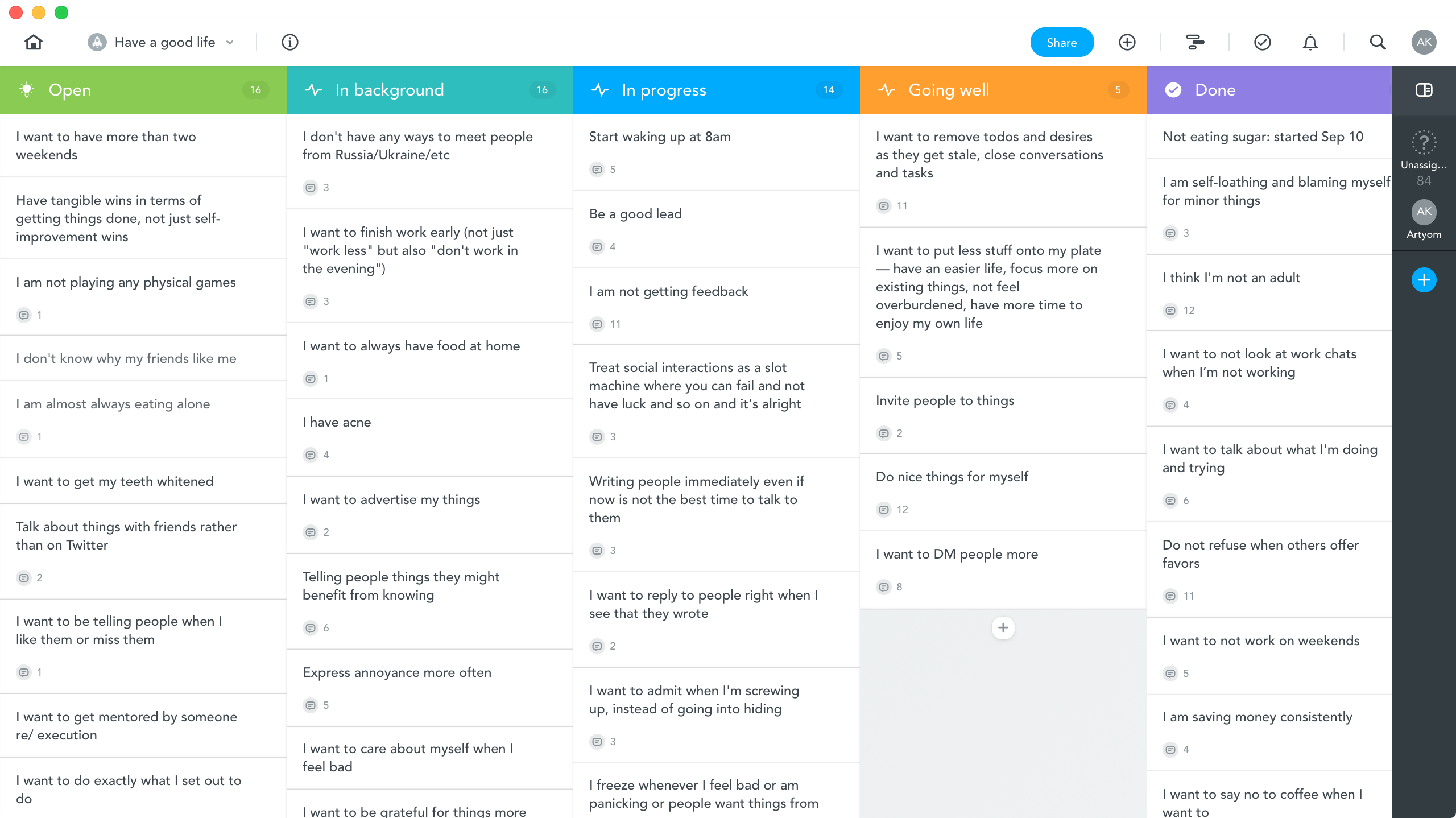
The columns are:
- Open: this is a problem, I guess
- In background: this is a problem and also I haven't completely forgotten about it
- In progress: ...I am actually making some progress every now and then
- Going well: ...and I even think it's going well!
- Done: okay, I think this is solved.
Feel free to invent your own columns.
You can use anything for keeping the board—Trello, MeisterTask, Roam, Notion, whatever. The only requirement is that the board should have a way to add comments to entries.
How to use the board
Whenever you notice a problem you want fixed, put it into the board.
Whenever you have any thoughts about the problem, or whenever you do something that contributes to solving it, add a comment to the board.
That's it.
Examples of comments (abridged)
Card: "Start lifting"
- October 6: "I want to start lifting when I'm in Sweden"
- November 20: "Started lifting in Cyprus, after reading about lifting weights in Taleb’s book"
- November 24: "Still lifting but want to see if anything happens after I move to Poland"
- December 5: "Gyms are closed so will have to buy a dumbbell"
- December 29: "Ordering a barbell"
- January 8: "Got the barbell"
- January 11: "Lifting every day"
- January 12: moved the task to Done
Card: "Express annoyance more often"
- August 1: "Blocked Eigen"
- August 2: "Complained to [grocery store] about the cashier"
- August 31: "Ranted about Russian today"
- September 7: "Said I don't like animated stickers"
- November 7: "Tweeted at people who went 'count all votes'"
- December 30: "Wrote a three-star review for the OP-Z app"
- December 30: "Wrote a 3-star review for The Mexican"
- January 4: moved the task to Done
Why the board works
The board is a bit like cognitive behavioral therapy taken to the maximum. It has two elements:
- Long-term CBT: By keeping track of all issues, big and small, you will eventually have incontrovertible evidence that things get fixed—even if they seem unfixable at first, or even if they don't get fixed on the first try, etc.
- Short-term CBT at scale: By keeping track of everything that happens per issue, you will eventually have evidence that each particular thing is getting better.
The second point is why the app/method you use must have a way to add comments to the board. Daily comments > weekly reviews.
For some issues—e.g. "I want to change my mind easily" or "I want to get more feedback"—it is very hard to notice that you actually started getting better! Every time you succeed, you will also remember all the previous times when you chickened out. Comments are super important here, because you want to move the task to "Done" when you got, say, 3–5x better at [whatever the issue was], not when you completely and utterly defeated it.
It's important not how often you use the board itself, but how much time you spend noticing. If you tweet some observations instead (or in addition to) adding them to the board, this is great. If you mention things to friends whenever you notice them, this is also great. Anything that increases your "observational throughput".
How I arrived at the board
About a year ago I had accidentally stumbled at a very interesting thing.
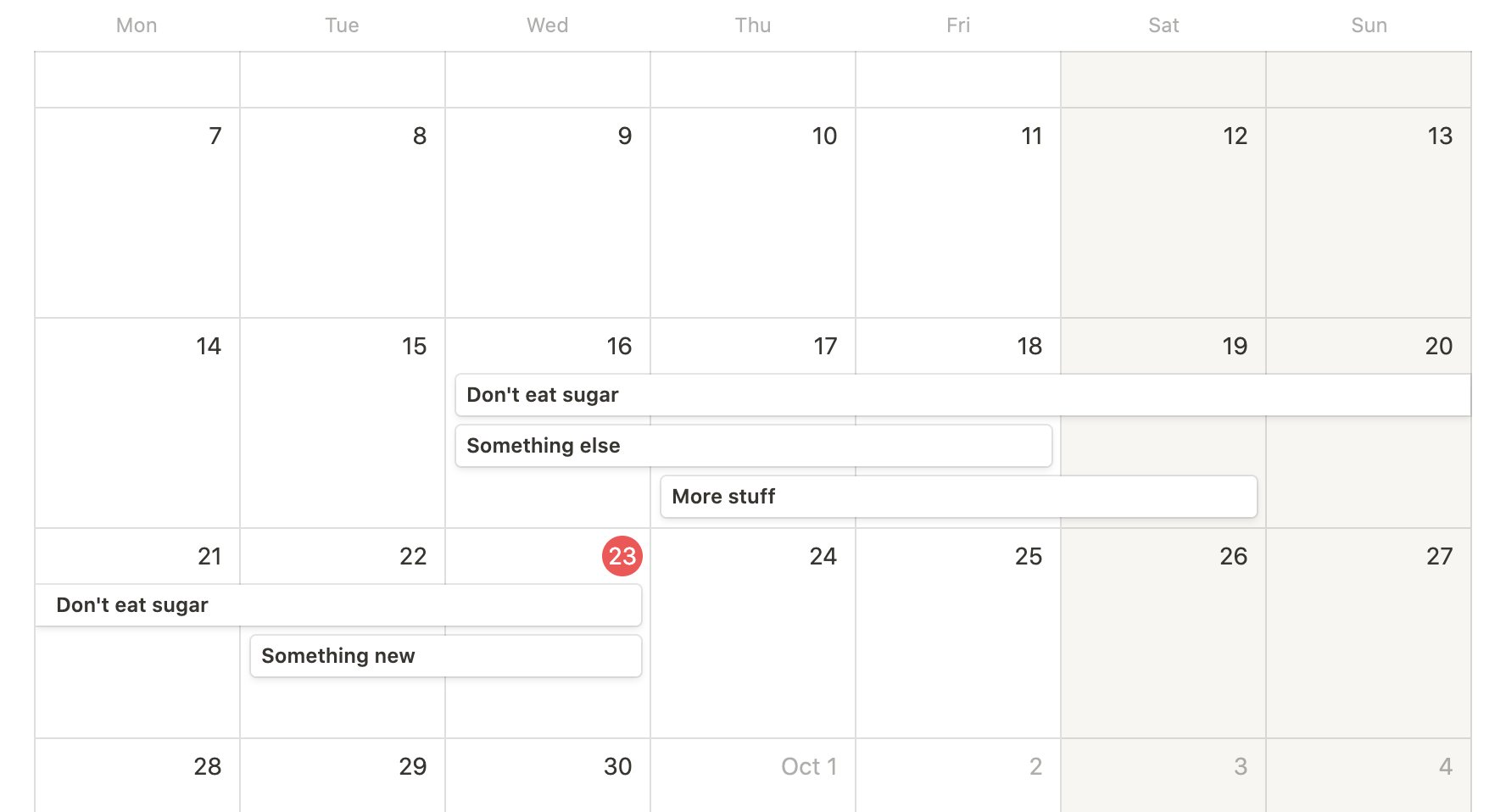
I had a calendar page in Notion, and for every day I was tracking what self-improvement projects were going on during that day. It looked roughly like this.
I was dragging each of them to the next day if "that's still a thing", and if not—I would just stop dragging it. The most important thing was not to force myself to improve—but simply track what was going on.
At first it was depressing, because the average self-improvement idea only lasted for 4–10 days. But then I noticed that I always had about four things going on at any given time. That is, no matter how bad I was at keeping each individual thing alive, I was still applying constant amount of effort throughout my life. I was not in danger of getting stuck.
The page gave me a visceral demonstration that I am making progress even when I think I'm not. However, otherwise it was clumsy. I abandoned it, and half a year later remembered that keeping that calendar page was good for me—and made a board instead.
Tips and tricks
Don't force yourself
Never, ever, ever, use the board to force yourself to do anything. The board is a delicate flower. By forcing yourself, you will murder the board.
If you want to get something done but can't be assed to take even the slightest step towards it—that's what the "Open" column is for. Put it there and stop blaming yourself for not getting it done. Forget about it for months. The virtuous cycle of self-improvement is:
- stop worrying about things that you can't fix;
- fix the things you can fix;
- your life gets better, you have less stress, you believe in yourself more;
- now some of the things you couldn't fix will slowly become fixable;
- repeat.
One of the functions of the board is to remove stress. By putting a problem into the "Open" column, you ensure that as long as the board exists, you won't entirely forget about the problem—which frees you up to stop thinking about it. Or it frees me up, at least. Not always. But sometimes.
The board is not for planning
You should not use this board to plan your life, or plan to fixing the problems that end up on the board. You should use the board to record what is happening.
If you treat the board as a list of things to do, the board will fail. If you attach negative feelings to not knowing how to solve something—and if the board serves for planning, this will happen—the board will also fail.
Keep the board truthful
The board must be an accurate representation of how things are going.
If something is "In progress", but recently you lost motivation to do anything in that direction—it is tempting to keep it "In progress" for a few more days. Because you know that when you put it back into "Open", you will forget about it.
Put it back into "Open" anyway. Again: the moment you try to use the board to force yourself to do things, the board will die.
People install todo list apps, use them to force themselves to get things done, the todo list dies at some point, and the cycle repeats. If this is you—don't turn the board into another todo list. You've tried enough of the same thing already.
Collect observations
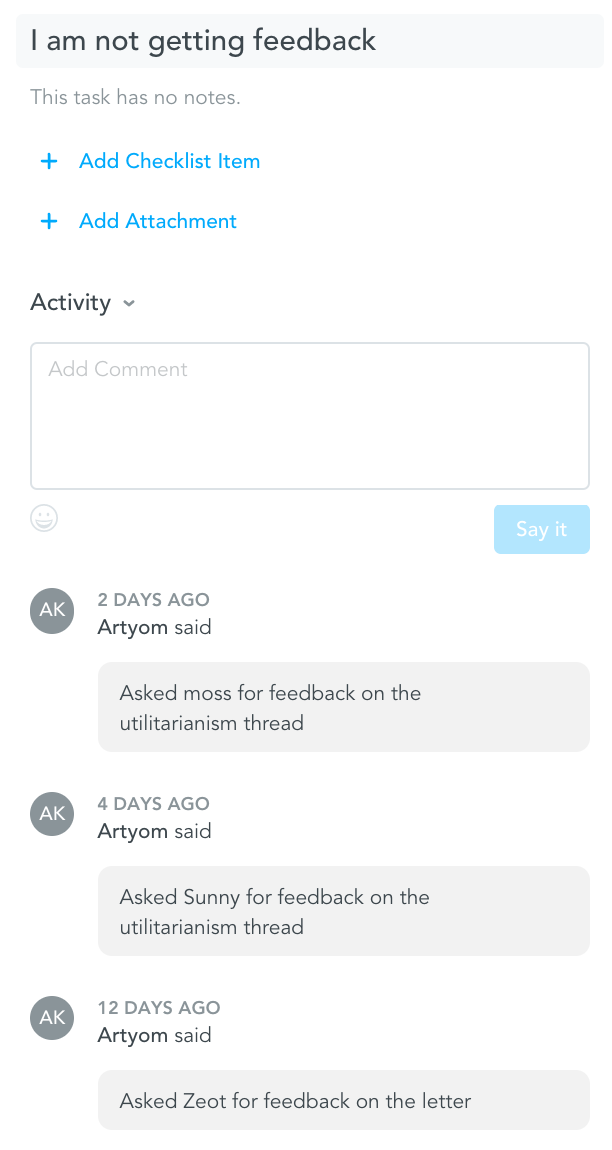
Whenever I make any step towards solving anything on the board, I add it as a comment.
It makes me pay attention to what I'm doing—which makes it easier to do more of that.
Also, it makes me aware of what's going well and what isn't, CBT-style. It's evidence—no, I am actually not making zero progress, I'm making some progress. It is never entirely convincing, but it still helps.
Treat everything as a multi-vector-attack problem
This is actually not a tip on how to use the board. It's a thing that the board teaches you.
You stop hoping for magical cure solutions, and start expecting that everything will take N different approaches to fix, and you have to be patient and keep doing those even if they don't work out at first. Which is useful—because that's how things actually work, sometimes.
For example, getting better sleep might require:
- finishing work more early,
- being more confident about telling friends "no, I'm going to sleep",
- fixing your eating schedule,
- making yourself happier (so that you aren't tempted to drink a glass of wine at 10 PM),
- etc.
Each of those is a huge problem on its own! It's easy to become hopeless—"I try and try and try to have better sleep, and nothing works". Duh. Nothing works, because each time you try to solve just one problem out of five (or ten). Instead, the board shows you that some problems are particularly wicked—sleep, getting laid, doing better at work, etc—and you can fix them only by fixing many smaller problems, one by one.
Review the board every once in a while
I do it every week. Just move things around.
Tweet the wins
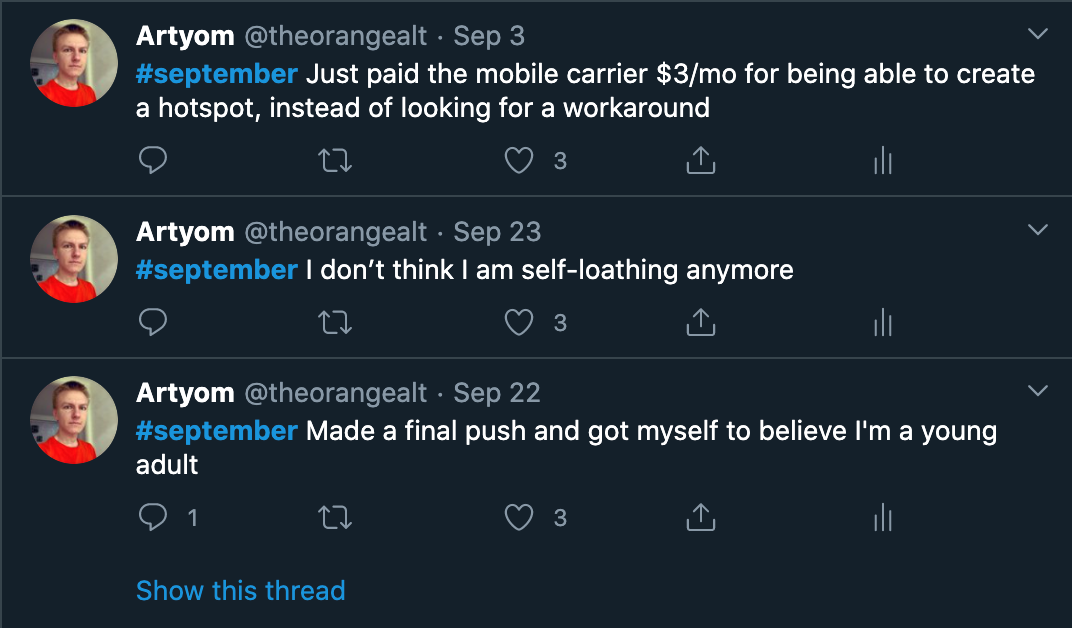
In addition to keeping the board, I also tweet whenever I move something to "Done" and add the current month's hashtag. For example: #september. If I do something nice that doesn't fit into the existing board cards, I tweet it too.
At the end of each month, I collect all tweets with the month's hashtag. This provides additional motivation: I am making progress. Things get fixed. Things will get fixed eventually.
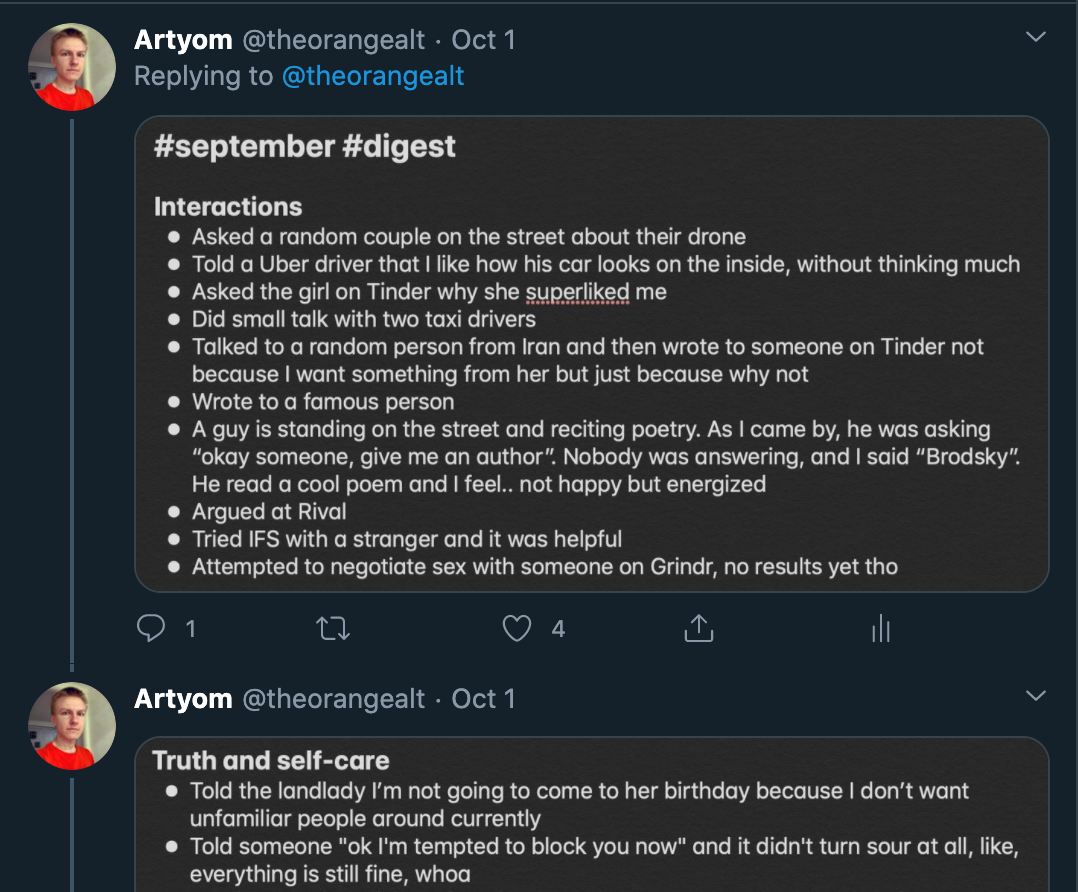
P.S.
The principles behind this system are further elaborated in: